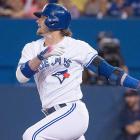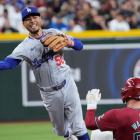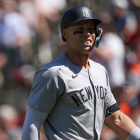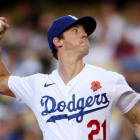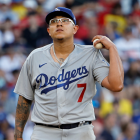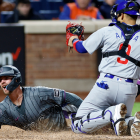The year was 2014, and A.J. Preller had a plan. Hired as the Padres new general manager in August of that year, Preller noticed a jarring trend within baseball: Home runs seemed to be going extinct.
The numbers bore that out. In 2014, MLB hitters combined to crack 4,186 homers. That marked the lowest total since 1993 -- when Major League Baseball had two fewer teams.
Given free rein to reshape the roster to his liking, Preller embarked on one of the most aggressive winter shopping sprees in baseball history. In a span of just a few days, he reeled in Matt Kemp, Wil Myers, Justin Upton, Derek Norris, and Will Middlebrooks. All five players came with various holes in their game, ranging from lousy defense to slow feet to holes in their swing. But one thing all five could do was hit the ball a long, long way when they connected. Moreover, all five were right-handed, underscoring Preller’s attempt to corner the market on righty sluggers, an even scarcer commodity.
The gambit failed spectacularly. Despite the addition of that big five (as well as front-line starting pitcher James Shields and top closer Craig Kimbrel), the Padres somehow won three fewer games in 2015 than they had the year before. Today, San Diego’s in the throes of a huge rebuild, assembling as much young talent as possible. If all goes well, the Friars might be competitive by the end of the decade. But in the here and now, they might be the worst team in all of baseball.
What’s even weirder is what’s happened to power-hitting in the two short seasons since that infamous buying binge. After that huge slide in 2014, home runs jumped by nearly 15 percent league-wide in 2015. Last season, power hitting exploded. MLB hitters combined to bash 5,610 long balls in 2016. That marked the second-highest total in baseball history. The only season more homer-happy was 2000, when PED use was at its peak, Mark McGwire’s forearms were the size of Nebraska, and the best-selling album in America was NSYNC’s “No Strings Attached.”
What the hell happened? How did Preller, a highly-regarded talent evaluator with the Rangers before coming to San Diego, so badly misread the market? And how exactly did we go from power hitters being a needle-in-a-haystack commodity to the defending NL co-home-run champ now riding the pine in New York? How is it that every 175-pound human on every roster in baseball now seems capable of bopping 30 out of the park?
A consensus has started to emerge in baseball on the answer to that question. Hitters are hitting more home runs, because they’re trying to hit more home runs.
The evidence is everywhere. Blue Jays star third baseman Josh Donaldson, a once good but not quite super-elite prospect, is now a perennial MVP candidate because of his approach at the plate. Watch this tutorial Donaldson offers with Mark DeRosa at MLB Network. Far smaller than the behemoths of the PED era, Donaldson walks DeRosa through basic concepts like weight transfer in describing his prodigious power. But all of it starts with a basic approach. Donaldson’s goal is to never, ever, ever hit a groundball. Hit everything in the air, and let strength and technique do the rest.
Orioles masher Mark Trumbo is another disciple of the swing-hard, swing-up school of hitting. Long known for his power and not much else, Trumbo last season gave up pretending to hit the ball to all fields, shorten up in pitcher’s counts, and all the other defensive techniques that hitters are supposed to follow. Instead, he ramped up the launch angle with which balls fly off his bat, allowing him to parlay his natural pop into a career-high, MLB-leading 47 home runs. Dodgers third baseman Justin Turner and numerous other players have traced similar paths by learning to do nothing more complicated than swing for the fences.
With detailed statistical data now available to guide hitters on their swing paths, sluggers can more easily track and improve the angle at which balls take flight once they’ve hit them. According to Statcast data, league-wide launch angles climbed to an average of 11.5 degrees per batted ball in play in 2016, up from 10.5 degrees in 2015.
Of course, even hardcore statheads might have a hard time understanding what a one-degree rise in launch angle means, absent context. Fortunately, thanks to analysts like MLB.com’s Daren Willman, we have more detailed data which show that when batters hit balls at a higher launch angle, good things do indeed happen.
Biggest increase in average launch angle, 2015-16
Out of 142 players with at least 250 batted balls in both seasons:
| | PLAYER | 2015 AVG LAUNCH ANGLE | 2016 AVG LAUNCH ANGLE | +/- | 2015-16 SLG |
|---|---|---|---|---|---|
1. | 5.4 degrees | 11.8 degrees | +6.4 | Up .446 to .533 | |
2. | 8.2 degrees | 14.5 degrees | +6.3 | Up .465 to .502 | |
3. | 10.7 degrees | 16.8 degrees | +6.1 | Up .449 to .595 | |
4. | 6.1 degrees | 11.7 degrees | +5.6 | Up .336 to .499 | |
T-5. | 8.4 degrees | 13.0 degrees | +4.6 | Up .402 to .482 | |
| T-5. | Brandon Belt | 15.8 degrees | 20.4 degrees* | +4.6 | Up .478 to .474 |
*- Highest in MLB in 2016, minimum 250 batted balls (Source: MLB.com)
OK, so we’ve established the how. But what about the why? If trying to hit home runs has always been the best way to hit more home runs, why haven’t hitters always been this aggressive about trying it?
One plausible explanation is that hitting groundballs has become increasingly less likely to produce positive results in recent years, thanks to Ted Williams-like defensive shifts and other highly specialized alignments. That in turn could cause players to become more determined to lift balls into the air. Scott Spratt, research analyst for Baseball Info Solutions, said the surge in shift frequencies has indeed been huge over the past few seasons; he offered the data to back that up.
MLB shifts on batted balls
| Year | Shifts | % Increase |
|---|---|---|
2011 | 2,350 | - |
2012 | 4,577 | 95% |
2013 | 6,882 | 50% |
2014 | 13,299 | 93% |
2015 | 17,825 | 34% |
2016 | 28,133 | 58% |
Source: Baseball Info Solutions
Still, one American League exec I queried didn’t dispute the rise in shift frequency or home runs -- only the argument that the former is causing the latter.
“I don’t think hitters’ swing path was a result of infield shifts,” the AL exec said. “I think they are independent. Bat path started before, as players realized the cost-benefit analysis of that strategy. And the baggage that comes with high strikeouts waned as people did the math. I think uppercut swings are fine given the rewards of extra-base hits and penalty of a strikeout. Tony Gwynns and Wade Boggses don’t exist now. Just as Mike Napoli and Chris Davis didn’t exist back in the 80’s. The infield shift didn’t have anything to do with that. If anything, the batted ball distribution is more extreme because people are trying to hit more flyballs and the shifting is a result of that, not the cause.”
Last week, MLB.com writer Mike Petriello spoke to a bunch of other hitters who said the same thing: It all comes down to cost-benefit analysis. If a hitter can get over the idea of a strikeout being a disaster, they can turn it loose, knowing how much more valuable a home run usually is compared to a well-placed single.
Let’s assume that this all really just comes down to players seeing little downside in swinging for the moon. Baseball is still a game of adjustments. At some point, a group of pitchers or a handful of savvy teams will find ways to exploit everyone in the league trying to emulate Pedro Cerrano.
In fact, those efforts have already begun. With umpires becoming a little more likely to call pitches above the belt as strikes, pitchers become more incentivized to throw high fastballs; when so many hitters take big, uppercut swings, high heat offers the possibility of a great equalizer. The Tampa Bay Rays in particular have preached the value of high fastballs, both in the pitchers they try to acquire, and their own player development. Individual pitchers like Marco Estrada have shown that serving a heavy diet of high fastballs can be a successful tack in today’s game, even if those fastballs don’t scream in at 98 mph.
Justin Hollander, the Mariners’ director of baseball operations, echoes that thought. At the same time, becoming predictable with high fastballs can lead to all kinds of bad outcomes. That means good, old-fashioned pitching variety is a virtue.
“I think the answer is guys going both above and below the zone,” Hollander said. “If everyone is in the ‘elevate and celebrate’ mode, then you either have to pitch them above the zone with rising fastballs, or start running out sinkers that make it tougher to lift.”
Then again, pitch location might not matter as much as pitch selection. Players with uppercut swings are going to whiff more often, because their timing has to be more precise to accomplish their goals (hitting home runs) than a Gwynn or Boggs would need to be to simply make contact and flip the ball somewhere for a soft single. And nothing messes up a hitter’s timing more than changing speeds effectively.
In fact, study the past 15 years of baseball history and you’ll find that teams like the Rays and pitchers like Estrada represent outliers, since fastball usage has been falling steadily over the past decade and a half. The recent spike in uppercut swings might thus be a reaction to an increase in bendier, sinking pitches, the kind that need to be significantly lifted for hitters to do real damage.
If and when certain pitches and pitch locations fail to prevent batters from hitting balls into the air, the next step could thus become building stronger outfield defenses. We can take the theory one step further too: If more hitters succeed in driving pitches to the outfield, then teams could take their finite resources and focus more on outfield defense than infield defense. The Mariners in particular moved aggressively to upgrade their outfield D over the winter, acquiring skilled flyball chasers Jarrod Dyson and Mitch Haniger while shipping out less mobile outfielder Seth Smith.
“I think in a perfect world every team would improve their outfield defense,” Hollander said. “But in our case it was imperative because 1) it was problematic last year and 2) our ballpark and schedule demanded it. With the amount of games we play in bigger outfields, having below-average outfield defense is just not compatible with run prevention. If we played in the NL Central, maybe we would align differently or make different choices. But below-average run prevention in the outfield really punishes us in our circumstance.”
Another possible way to approach baseball evolving into a more home runs-and-strikeouts game? Lean into the idea of fewer fielding chances occurring, and focus your resources on building the most potent lineups possible.
“With so many strikeouts, defense in general has become less important,” said one AL executive who requested anonymity, not surprising given how bold it is to discount the value of defense in today’s game -- even if in this case he might be right.
Or is he? In addition to upgrade their outfield defense this winter, the Mariners also traded for smooth-fielding shortstop Jean Segura. While well-executed shifts might help a bit when it comes to covering for less mobile infielders, and a rise in home runs and strikeouts might mean fewer balls hit into play, Hollander said the game’s changes haven’t been dramatic enough to significantly negate the value of skilled defenders ... at every position.
Spratt agreed.
“Maybe it’s going to be more important for teams to get good defensive players in the outfield going forward, if there is less they are able to do with positioning to get an advantage,” Spratt said. “I feel like teams could [also] reasonably get one really good defensive infielder like an Andrelton Simmons type and literally always position him on the batter’s pull side with shifts. How much would it really hurt then to have a bad second baseman if he doesn’t ever have the ball hit to him?”
There’s one other logical possibility here. Yes, pitchers can try to mess with hitters’ timing and plane of vision. Sure, teams can deploy all kinds of fancy defensive alignments and incredibly nimble fielders to handle the balls that don’t end up over the fence. At the same time, why try to fight City Hall? If your opponents are going to breeze into town and try to go yard every time up, maybe the best answer is to just be better at it than the other guy, and try to win a ton of 8-7 slugfests?
“I think the next steps are probably how [hitting for power] is scouted and implemented in player development,” said Hollander. “Needless to say we’ve all seen the impact changes to launch angles can have on players. So identifying those players and implementing changes that fit their skill sets [becomes] really important.”
Whatever happens next, one thing is clear: The long ball is back. And the next equivalent of the Preller Plan probably won’t look anything like the last one did.













